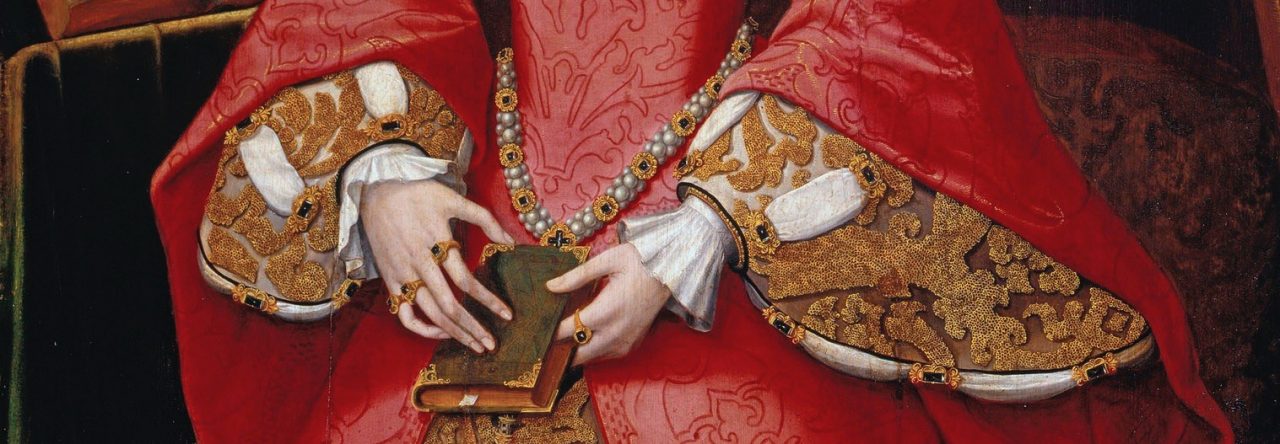By Charlotte Epple
In the Catalogue of Scandinavian Books in the British Library Printed Before 1801, librarian Peter Hogg remarks that, regarding Iceland, “it is noteworthy that a higher proportion of the owners than in any other country were women.”[1] Ownership inscriptions of women are indeed common in early Icelandic prints of any library. You can find many by clicking through digitized books in the repository of the National and University Library of Iceland.
One book I came across there contains a striking full-page painted ownership mark. Colourful interlocking rings containing the initials S. T. D. fill out the verso side of the front flyleaf of a copy of Ein ný húspostilla (“a new house postil”).


This collection of devotional texts was published in 1597 by bishop Guðbrandur Þorláksson, a crucial figure in the history of printing in Iceland. Most books from this period are religious works, usually small octavo editions on poor quality paper, reflecting the scarcity of resources in this fairly remote print shop. This húspostilla is no different. It is stained, creased, and mended at the edges – traces of heavy use over centuries.

The ownership mark contains only initials, but even from those it is immediately clear that this was a woman’s book. Most Icelanders don’t have family names, instead using their fathers’ first names with the suffix –son or –dóttir (‘daughter’). The D. therefore indicates a feminine name. A note on the preceding page, signed and dated 1779 at Reykhólar, gives us her full name, Sigríður Teitsdóttir. She can be identified as the daughter of Margrét Jónsdóttir and Teitur Arason, sýslumaður (a kind of local offical) of Barðastrandarsýsla, an administrative district covering the southernmost part of the Westfjords region of Iceland. The family lived at Reykhólar, a small cluster of farms, where Sigríður was born in the early eighteenth century.[2]
The painted bookplate was likely made for Sigríður by her son-in-law, the painter, bookbinder, and scribe Hjálmar Þorsteinsson. A very similar design featuring the same interlocking rings can be spotted on the title page of the manuscript JS 162 fol, dated 1783.[3]


He probably made the bookplate a few years earlier, since the dedication in Sigríður’s own, rather shaky handwriting tells us that she bequeathed the book to her son Jochum Jónsson in 1779: “Þessa Postillu gjef Jeg underskrifud syne mijnum elskulegum Jochum Jons syne og -óska hann lese hana og […]. Reykholum þann 27. Augusti Anno 1779. Sigridur Teitsdotter” (This postil I, the signatory, give to my beloved son Jochum Jónsson and wish that he may read it and […]. Reykhólar, August 27th 1779. Sigríður Teitsdóttir).[4]

Another note on the inside of the front cover, made 80 years earlier, indicates that the book had previously belonged to Eggert Snæbjörnsson, Sigríður’s maternal grandfather.

Her family was clearly well-off economically, and Sigríður herself went on to marry a vicar. It is therefore likely that there were many books in the family. Incidentally, a number of Icelandic manuscripts can be linked to her male relatives.[5] This húspostilla shows that there wasn’t just a household library, but that she also had her own personal books. Her name also shows up in a copy of the 1766 edition of Meditationes passionales, today in the British Library.[6] There may very well be more of her books out there, dispersed across libraries in Iceland and elsewhere.
Source: Copy Í252Þór digitised by the National and University Library of Iceland, permalink: https://baekur.is/bok/277502e2-849a-4f16-b631-89af3713a293. Images reproduced with permission.
Further Reading
Bogi Benediktsson á Staðarfelli. Sýslumannaæfir 2. Reykjavík: Hið Islenzka bókmentafélag, I prentsmiðju Einars þórðarsonar, 1881. https://archive.org/details/sslumannafir00orgoog.
Hogg, Peter. Catalogue of Scandinavian Books in the British Library Printed Before 1801 3. London: British Library, 2007.
Jón Jónsson. Meditationes Passionales, Edur Pijslar Hugvekjur […]. Hólar í Hjaltadal, 1766 [copy belonging to the British Library, shelfmark: General Reference Collection 866.l.4.].
National and University Library of Iceland. “JS 260 Fol.” https://handrit.is/manuscript/view/is/JS02-0162 [digital catalogue entry]
[1] Peter Hogg, Catalogue of Scandinavian Books in the British Library Printed Before 1801 3 (London: British Library, 2007), p. xix.
[2] For an overview of Sigríður’s family tree, see Bogi Benediktsson á Staðarfelli, Sýslumannaæfir 2 (Reykjavík: Hið Islenzka bókmentafélag, I prentsmiðju Einars þórðarsonar, 1881), accessed October 30, 2022, https://archive.org/details/sslumannafir00orgoog, 122–25.
[3] “JS 260 Fol.” accessed November 1, 2022, https://handrit.is/manuscript/view/is/JS02-0162 [digital catalogue entry]. The manuscript contains bishop’s sagas and the illustration is located at the bottom of the title page.
[4] Author’s transcription and translation, names normalized to Modern Icelandic spelling in the English version.
[5] According to the registry of names associated with manuscripts in the joint online catalogue handrit.is, the following number of provenances are recorded for members of her family: Eggert Snæbjörnsson: 2, Teitur Arason: 1, Hjálmar Þorsteinsson: 10. There are no manuscripts recorded as belonging to Sigríður herself or female members of her family.
[6] Jón Jónsson, Meditationes Passionales, Edur Pijslar Hugvekjur […] (Hólar í Hjaltadal, 1766 [copy belonging to the British Library, shelfmark: General Reference Collection 866.l.4.]).
